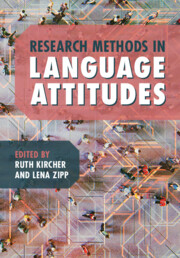Book contents
- Research Methods in Language Attitudes
- Research Methods in Language Attitudes
- Copyright page
- Contents
- Figures
- Tables
- Contributors
- Foreword
- Acknowledgements
- 1 An Introduction to Language Attitudes Research
- Part 1 Analysis of the Societal Treatment of Language
- Part 2 Direct Methods of Attitude Elicitation
- Part 3 Indirect Methods of Attitude Elicitation
- 12 The Matched-Guise Technique
- 13 The Verbal-Guise Technique
- 14 The Theatre-Audience Method
- 15 Experimental Methods to Elicit Language Attitudes among Children
- 16 The Implicit Association Test Paradigm
- Part 4 Overarching Issues in Language Attitudes Research
- References
- Index
- References
12 - The Matched-Guise Technique
from Part 3 - Indirect Methods of Attitude Elicitation
Published online by Cambridge University Press: 25 June 2022
- Research Methods in Language Attitudes
- Research Methods in Language Attitudes
- Copyright page
- Contents
- Figures
- Tables
- Contributors
- Foreword
- Acknowledgements
- 1 An Introduction to Language Attitudes Research
- Part 1 Analysis of the Societal Treatment of Language
- Part 2 Direct Methods of Attitude Elicitation
- Part 3 Indirect Methods of Attitude Elicitation
- 12 The Matched-Guise Technique
- 13 The Verbal-Guise Technique
- 14 The Theatre-Audience Method
- 15 Experimental Methods to Elicit Language Attitudes among Children
- 16 The Implicit Association Test Paradigm
- Part 4 Overarching Issues in Language Attitudes Research
- References
- Index
- References
Summary
This chapter describes how to carry out an attitudinal study using the matched-guise technique (henceforth MGT), an indirect method to elicit language attitudes. In its traditional design, participants listen to the voices of several speakers who are each reading or saying the same text in different linguistic varieties (i.e. guises), and then evaluate them on a series of traits – usually along the dimensions of status and solidarity. Participants are not aware that they are listening to the same speaker more than once, which allows researchers to attribute any differences in ratings to the linguistic varieties under investigation. This chapter discusses the advantages of using the MGT, as well as how to overcome or minimise its drawbacks. The chapter also considers key issues of planning and research design (e.g. how to choose culturally appropriate listening stimuli and personal traits) as well as appropriate statistical analyses of data obtained by means of this method. The main points of the chapter are illustrated with a case study of attitudes towards Spanish, English, and different types of code-switching in Puerto Rico.
Keywords
- Type
- Chapter
- Information
- Research Methods in Language Attitudes , pp. 185 - 202Publisher: Cambridge University PressPrint publication year: 2022
References
Suggested further readings
- 5
- Cited by



